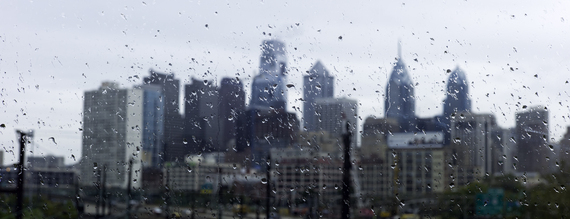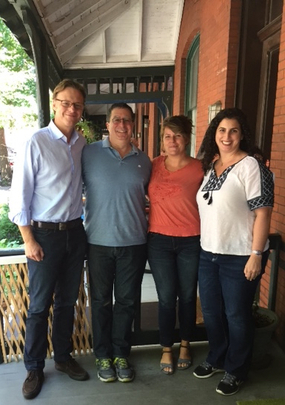I recently had the pleasure of meeting Howard Neukrug, the former leader of Philadelphia's water utility, and the man behind the city's innovative plan to manage stormwater with nature, and in doing so, transform urban neighborhoods. Philadelphia aims to become the greenest in America--reducing pollution from rainwater runoff by 85 percent while saving the city billions. He is fundamentally changing the city's relationship with nature, and other cities are watching with great interest. When I met with urban planners in China and in Mexico, reports about Neukrug's work were sitting on their desks.
Pascal Mittermaier: Can you tell me about the origins of Philadelphia's green infrastructure program to manage urban water issues? What is unusual about the city's approach? What is your formula for success?
Howard Neukrug: Philadelphia's green programs really began as pushback to an expensive grey infrastructure mandate from the U.S. Environmental Protection Agency to reduce sewer overflows that occur even during the most minor rainstorms. The traditional methods of remediation relied on making bigger, deeper and longer sewers--we were looking at a 34-foot diameter, 30-mile-long tunnel, with dozens of shafts and pumping stations, located 150 feet below the Delaware River! Following a rain event, the "stored" overflows were to be pumped up to our wastewater plants for treatment.
We called this the "100-year tunnel" since it would have taken us that long to be able to afford the nearly $10 billion construction cost. And once completed, we may have minimized the overflow problem, but there would have been little other funds available in those hundred years to support our water system or help build a more sustainable, resilient city.
And to make this change, the water sector needed to expand its definition of "sustainable" from "a longer lasting concrete treatment structure" to a more universal understanding that sustainability is a bigger concept that involves more than just managing overflows.
So, instead of expanding our infrastructure, we went in the other direction--we put together a plan to price, value, reuse, recycle, infiltrate, transpire or otherwise manage, every drop of rainwater we could. We called this plan "Green City, Clean Waters" and started to invent the millions of ways to reduce the amount of rainwater that arrived at our sewer inlets. The goal was to consider rainwater as a commodity and a resource--if it enters a sewer drain it becomes a costly waste product.
It was the early 2000s and not many other cities were looking to do this on such a massive scale. And it was (and is) difficult because every square foot of a city--from rooftop, to backyard, to sidewalk, to street--is built at a gradient, or slope, designed specifically to send rainwater to a sewer drain as efficiently as possible. In essence, we were proposing to reverse the slope of a city.
There is no single formula for success--and we still don't know whether ultimately we will succeed with transforming 10,000 acres of the city's impervious cover to stormwater managed "green" space. But creating a vision, providing the leadership, having an environmental mandate, and a new generation of "millennial" engineers and scientists--all passionate about changing the world--are a great start for any sustainable endeavor.
A secret to our success is that once we valued the resource, the public and private sectors came together and exponentially expanded the green infrastructure product innovation and business models, bringing its costs down and its effectiveness up.
PM: Over the past five years, Philadelphia has constructed more than 700 acres of green rain gardens and swales in streets, parks and schools. In the next five years, Philly wants to do another 700 acres and ultimately reach 10,000 acres. How will this be done? What do you think the Conservancy's role could be?
HN: Changing the world--or even one small piece of it--requires a lot of trial and error. We divide the city into communities, needs, types, gradients, opportunities, public, private and quasi-government.
We do this because although it is mainly the land's use and management that determines the nature and quality of all our city's water, a water utility has little to no control over that land. Within every space we look to find supporters, stakeholders, developers, civil servants, environmental organizations and try to learn how we can offer leveraged benefits that meet our mutual interests. Oh, and in case that is not enough, we set stormwater control regulations on any development (which means redevelopment in a city like Philadelphia), we set stormwater fees and credits for landowners to encourage change, and offer grants and other incentives for schools, churches, businesses and others to encourage support.
The Nature Conservancy arriving in Philadelphia brings years of experience in land management, stakeholder development, fund raising capacity and general branding that is only positive for a program like ours. More specifically, given the city's 40,000 vacant lots and 50-plus miles of waterfront along the Delaware and Schuylkill Rivers, there are many opportunities for the Conservancy to share your knowledge and expertise as the city revises its land management policies and approaches. We have a tremendous opportunity to rebuild an entire city and make its benefits reachable by all our residents--and hopefully reverse some existing issues involving jobs, environmental justice and social equity.
PM: If Philadelphia greens up 10,000 inner city acres, what would the impact be on water quality? What would the environmental and financial outcomes be?
HN: Our goal is not just to make our rivers and streams fishable and swimmable as required under the Clean Water Act, but also make our water resources drinkable, safe, attractive, accessible, abundant and available.
To do this we need to continue with our green approaches and expand and fortify our grey infrastructure where necessary. But we must also build fish ladders and waterfront access, and develop our land in a manner that respects and supports our water resources, our citizens and the ecosystems.
Getting to 10,000 greened acres is a terrific goal that will reduce billions of gallons of sewage overflow into our rivers and streams, and that in and of itself would be quite a success story. But because we are matching water management with support for a greener, more sustainable and resilient city, the benefits are expected to be multiplied manifold.
PM: What kind of social impact is your work having in Philadelphia? Has your thinking changed from a "utilitarian," water-management point of view to one that includes health and social outcomes?
HN: There are so many localized social, environmental and economic benefits from our work. But its impacts change with every project--a schoolyard, a community park, a new development with green space, a green (or complete) street, new development or a waterfront trail. And a water utility on its own cannot change the sustainable direction and resiliency of the city. It can only work with other forces, leverage its vast resources, and support an integrated approach to thinking about cities in the 21st -century. The trick is involving the public, the politicians, the developers, the regulators, the landowners and the land users to think differently about how water is managed in a city and how that can be a catalyst for other sustainable improvements.
PM: What else do you think The Nature Conservancy could offer in urban conservation?
HN: There are so many land and water opportunities for the Conservancy in a city like Philadelphia. You can provide support in areas such as landscape planning, land conservation, biodiversity and ecosystems, trails and waterfront access, stormwater management, innovative financing and stakeholder involvement. These efforts would all help Philadelphia become more resilient to climate change, provide local jobs, and make the city more livable and support its growth to become the greenest city in America.
Pascal Mittermaier is the Managing Director of The Nature Conservancy's Global Cities program, where he works to build resilient, livable, flourishing cities around the world. He tweets at @pascalmitter and his writing is archived at https://global.nature.org/experts/pascal-mittermaier.
Image captions: Photo #1: © iStock. Photo #2: Pascal Mittermaier, Howard Neukrug and city team. © Pascal Mittermaier.


